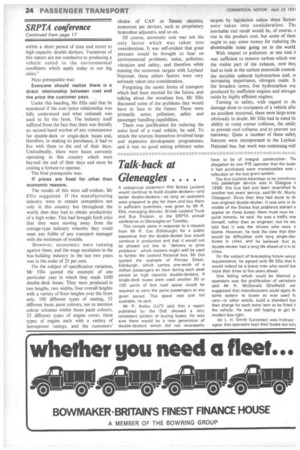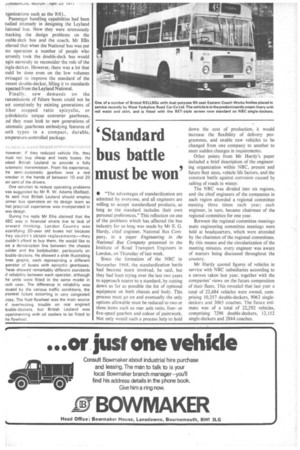Talk-back at Gleneagles . . . .
Page 26

Page 27

If you've noticed an error in this article please click here to report it so we can fix it.
A categorical statement that British Leyland would continue to build double-deckers—and better double-deckers--as long as operators were prepared to pay for them and buy them in sufficient quantities, was given by Mr R. Ellis, managing director, British Leyland Truck and Bus Division, at the SRPTA annual conference at Gleneagles on Tuesday.
This remark came in response to a request from Mr R. Cox (Edinburgh) for a public assurance that the double-decker bus would continue in production and that it would not be phased out due to "'delivery or price problems", which reasons might well be used to further the Leyland National bus. Mr Cox quoted the example of Princes Street, Edinburgh, which carries one-tenth of a million passengers an hour during each peak period on high capacity double-deckers. If single-deck buses were used another 50. or 100 yards of bus road space Would be required to carry the same passengers at any given Period. This space was just not available, he said.
Mr R. Bailey (LUT) said that a report published by the DoE showed a very consistent pattern of buying buses. He was sure there would be a new generation of double-deckers which did not necessarily
have to be of integral construction. Tim allegation by one PTE operator that the louse: it had purchased were monstrosities was z reflection on the bus grant system.
The first Leyland Atlantean to be introducer into passenger service was in Glasgow ii 1958: this bus had just been recertified fo another two years' service, said Mr W. Murra. (Glasgow). Since then they had stuck to thi rear-engined double-decker. It was only in thi middle of the Sixties that problems started ti appear on these buses; there must now be . quick remedy, he said. He was a traffic mai himself, rather than an engineer, but he wa told that it was the drivers who were ti blame. However, he took the view that then would be difficulties with long single-dec buses in cities, and he believed that th double-decker had a long life ahead of it in bi cities.
On the subject of forecasting future vehicl requirements, he agreed with Mr Ellis that h would indeed be a brave man who could loo more than three to five years ahead.
One failing which could be blamed o operators was the proliferation of variation: said Mr N. McDonald (Sheffield) wh, suggested that manufacturers could apply th same system to buses as was used fc cars—in other words, build a standard bus then charge for each extra item to be fitted t the vehicle. He was still hoping to get th modem bus right.
Mr L. H. Smith (Leicester) was inclined agree that operators kept their buses too lonc
-lowever, if they reduced vehicle life, they nust not buy cheap and nasty buses. He isked British Leyland to provide a fully iutomatic transmission. From his experience, he semi-automatic gearbox was a real vrecker in the hands of between 10 and 20 )er cent of the drivers.
One solution to reduce operating problems vas suggested by Mr R. W. Adams (Belfast). -le said that British Leyland should employ ormer bus operators on its design team so hat practical experience was incorporated in lew design.
During his reply Mr Ellis claimed that the IBC was in financial straits due to lack of orward thinking. London Country was ecertifying 20-year old buses not because hey couldn't obtain replacements--they xiuldn't afford to buy them. He would like to iee a demarcation line between the chassis milder and the bodybuilder, particularly on louble-deckers. He showed a slide illustrating hree graphs, each representing a different iperator of buses with epicyclic gearboxes. -hese showed remarkably different standards if reliability between each operator, although he units were fitted in the same model in iach case. The difference in reliability was :aused by the various traffic conditions, the preatest failure occurring in very congested :ities. The fluid flywheel was the main source if overheating trouble on rear engined iouble-deckers, but British Leyland was ixperimenting with oil coolers to -be fitted to he flywheel.




























































































































